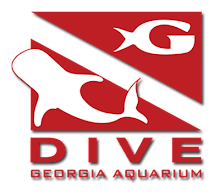 The Georgia Aquarium Dive Operations Team was called upon for a working dive. This time the objective was to remove the leftover carbon from the Ozone contact towers of an exhibit.
The Georgia Aquarium Dive Operations Team was called upon for a working dive. This time the objective was to remove the leftover carbon from the Ozone contact towers of an exhibit. The ozone contact towers themselves are tall towers through which the water of the exhibit flows during the filtration process. There are two of these 25ft tall towers that needed cleaning, and the only way to remove the carbon was by diving into the towers and siphoning it out.

The challenges of this project included the cold temperature of the water (around 55 degrees F), the overhead and confined space in which to work, and maintaining the flow of water and carbon through the siphon. The project lasted most of the day, and through hardwork and safe diving, was completed without problem.
Ron Barbieri, Mauritius Bell, and a Life Support Systems team member have a briefing before climbing into the first tower.
Time to get the gear on once the dive briefing is finished. We used surface supply which entails a full face mask for communications between the diver and the tender. Mauritius was to dive the first tower and Elliott Jessup the second.
As the tower was around 25 feet tall, a lift was used to get the diver and the two "spotters" to the top in order to get inside of the tower. 
It was very dark inside of the tower, thus cannister lights were used by the diver and overhanging lights were used for the spotters to keep an eye on the diver.

There was continued communications between the tender and diver. There were also communications via radio between the tender and the Life Support Systems staff members who were overseeing the siphoning process.
One Tower Down, One To Go!
Once the first tower was finished, the dive ops team moved onto the next tower.
Elliott gets suited up for the second dive.
Elliott and intern Windsor Gray were lowered after completing the second tower's dive. The second tower took less time than the first one, and before we knew it, we were finished.
Nothing like a job well done!











No comments:
Post a Comment